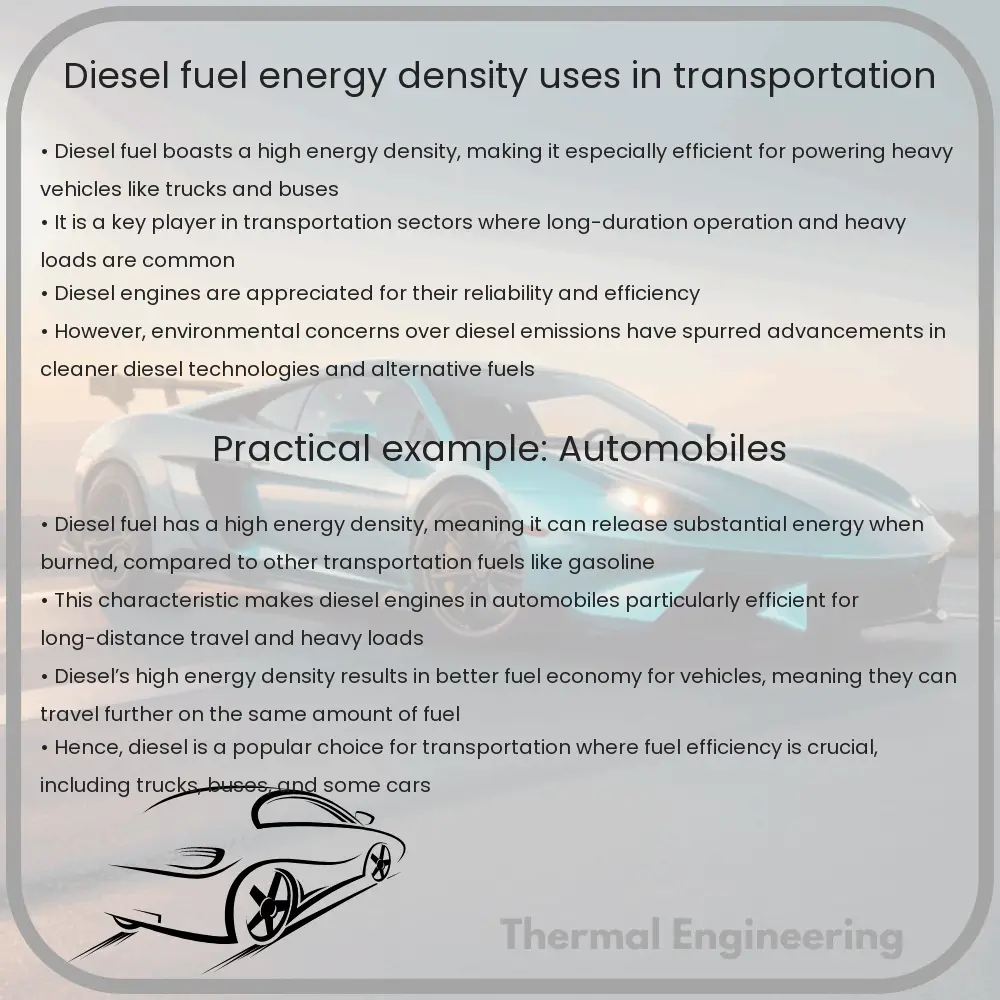Diesel fuel, with its high energy density, is vital for efficiently powering heavy vehicles, marine transport, and agricultural equipment.

Diesel Fuel: Understanding Its Energy Density and Uses in Transportation
Diesel fuel is a key player in the world of transportation, powering everything from large trucks to buses, boats, and farm equipment. Its prominence in the transportation sector is largely due to its high energy density compared to other fuel types, such as gasoline. This article aims to explore the concept of energy density in diesel fuel and its implications for use in various transportation modes.
What is Diesel Fuel?
Diesel fuel is a type of liquid fuel that is commonly used in diesel engines, a kind of internal combustion engine where air is compressed to a high temperature and then fuel is injected into the compressed air. Diesel fuel itself is primarily derived from crude oil, but it can also be produced from biomass, natural gas, and even coal through a variety of chemical processes.
Energy Density of Diesel Fuel
Energy density is a measure of the amount of energy stored in a given system or region of space per unit volume. For fuels, it is typically expressed in units of mega-joules per liter (MJ/L). Diesel fuel has a high energy density, generally around 35.8 MJ/L. This higher energy density means that diesel engines can travel significantly further on a liter of fuel than engines using less dense fuels like gasoline, which has an energy density of about 34.2 MJ/L.
Why is High Energy Density Important?
A higher energy density in diesel fuel translates to greater fuel efficiency. Vehicles employing diesel engines can cover greater distances using the same amount of fuel as a gasoline engine. This efficiency not only makes diesel a cost-effective option but also impacts the environmental aspect by reducing the per kilometer CO2 emissions when compared to gasoline engines.
Uses of Diesel in Transportation
- Heavy Vehicles: Diesel engines are preferred for heavy vehicles such as trucks, buses, and construction equipment due to their robust torque and durability. The high energy density of diesel fuel allows these vehicles to operate efficiently under heavy load conditions.
- Marine Transportation: Diesel is extensively used in marine transport. Ships powered by diesel engines benefit from the fuel’s high energy density, aiding in longer travel distances between fuel stops.
- Rail Transport: Diesel locomotives use diesel-electric technology, where the diesel engine powers a generator that produces electricity to drive the locomotive’s electric motors. Here again, the fuel’s energy density plays a crucial role in sustaining long-distance and heavy freight operations without frequent refueling.
- Agricultural Equipment: Farming machinery such as tractors and combines also predominantly use diesel fuel for the same reasons of efficiency and better high-load performance.
Diesel fuel’s high energy density coupled with the efficiency of diesel engines makes it an integral part of the global transportation infrastructure. Despite concerns over diesel emissions, ongoing advancements in diesel engine technology and cleaner diesel fuels continue to maintain diesel’s position as a critical fuel resource in various transportation sectors.
Environmental Concerns and Innovations
Concerns over the environmental impact of diesel emissions have led to innovations aimed at reducing these effects. Modern diesel engines are equipped with technologies like selective catalytic reduction and particulate filters to minimize NOx and particulate matter emissions. Additionally, the development and use of biodiesel—a diesel alternative made from vegetable oils and animal fats—are paving the way for more sustainable transportation solutions.
In conclusion, diesel fuel’s high energy density and subsequent fuel efficiency make it a valuable resource in transportation. While there are environmental challenges, ongoing advancements and innovations hold promise for cleaner and more efficient diesel use in the future.